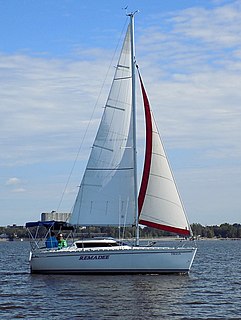Related Research Articles
The Hobie 33 is an American trailerable sailboat that was designed by Hobie Alter and Phil Edwards as one-design racer and first built in 1982. It was the first monohull design for Alter and his company, after establishing their reputations for their lines of surfboards and catamarans

The Tonic 23 is a French trailerable sailboat, that was designed by Philippe Harlé as a coastal cruiser and first built in 1985.

The Beneteau First 26 is a French sailboat that was designed by Jean-Marie Finot of Groupe Finot as a cruiser-racer and first built in 1984.

The Beneteau 331 is a French sailboat that was designed by Group Finot/Conq for cruising and first built in 1999.
The Coronado 25 is an American trailerable sailboat that was designed by Ed Edgar and Frank W. Butler as a cruiser and first built in 1966.
The Dehler 22 is a West German trailerable sailboat that was designed by E. G. van de Stadt and first built in 1983. It is van de Stadt's design number 374.
The Elite 25, also called the Feeling 720 NV, is a French trailerable sailboat that was designed by Michel Joubert of Joubert-Nivelt as a cruiser and first built in 1982.
The Ericson 23-2 is an American trailerable sailboat that was designed by Bruce King as a cruiser and first built in 1975.
The Ericson 25, also called the Ericson 25 Mark I is an American trailerable sailboat that was designed by Bruce King as a cruiser and first built in 1973.
The Ericson 25+, also called the Ericson 25 Mark II, is an American trailerable sailboat that was designed by Bruce King as a cruiser and first built in 1978.
The ETAP 20 is a Belgian trailerable sailboat that was designed by E. G. van de Stadt as a cruiser and first built in 1975.
The ETAP 28i is a Belgian sailboat that was designed by French designers Philippe Harlé and Alain Mortain (Harlé-Mortain), as a cruiser and first built in 1988.
The Freedom 21 is an American trailerable sailboat that was designed by Gary Hoyt and first built in 1982. It was available as a catboat or sloop rig.
The Eolia 25 is a French trailerable sailboat that was designed by Philippe Briand as a coastal cruiser and first built in 1983.
The Montego 19 is an American trailerable sailboat that was designed by Johannes "Jopie" Helsen as a pocket cruiser and first built in 1976.
The Quickstep 19 is an American trailerable sailboat that was designed by Stuart Windley as a pocket cruiser and first built in 1989.
The Pearson 23 is an American trailerable sailboat that was designed by William Shaw as a cruiser and first built in 1978.
The Balboa 26 is an American trailerable sailboat that was designed by Lyle C. Hess as cruiser and first built in 1969.

The Wavelength 24 is an American trailerable sailboat that was designed by Paul Lindenberg as a Midget Ocean Racing Club (MORC) racer and first built in 1982.
The Seafarer 24 is an American trailerable sailboat that was designed by McCurdy & Rhodes as a cruiser and first built in 1974.
References
- 1 2 3 4 5 6 7 McArthur, Bruce (2020). "Dehler 25 sailboat". sailboatdata.com. Archived from the original on 12 March 2021. Retrieved 12 March 2021.
- ↑ McArthur, Bruce (2021). "E. G. Van de Stadt 1910 - 1999". sailboatdata.com. Archived from the original on 11 March 2021. Retrieved 12 March 2021.
- ↑ "Van De Stadt Design". Boat-Specs.com. 2020. Archived from the original on 13 March 2021. Retrieved 12 March 2021.
- 1 2 3 4 5 6 7 8 9 Henkel, Steve: The Sailor's Book of Small Cruising Sailboats, page 227. International Marine/McGraw-Hill, 2010. ISBN 978-0-07-163652-0
- 1 2 3 4 5 6 "Dehler 25 Fin Keel". Boat-Specs.com. 2020. Archived from the original on 13 March 2021. Retrieved 12 March 2021.
- 1 2 3 4 5 6 "Dehler 25 Centerboard (Trunk)". Boat-Specs.com. 2020. Archived from the original on 13 March 2021. Retrieved 12 March 2021.
- ↑ McArthur, Bruce (2021). "Dehler Yachts". sailboatdata.com. Archived from the original on 11 March 2021. Retrieved 12 March 2021.
- ↑ "Dehler Sailboat builder". Boat-Specs.com. 2020. Archived from the original on 13 March 2021. Retrieved 12 March 2021.